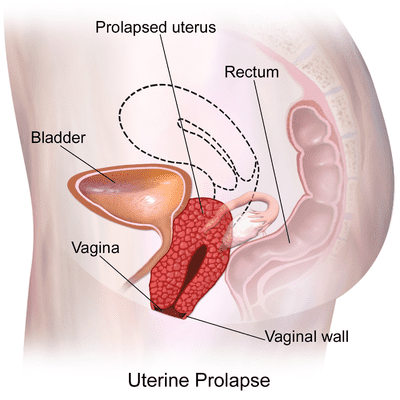A uterine prolapse occurs when the muscles and tissue in your pelvis weaken, allowing the uterus to prolapse (fall down). The uterus then descends into your vagina, sometimes exiting through the vaginal opening. Mild uterine prolapses do not necessitate treatment, but if the prolapse becomes chronically painful, you may need treatment.We assure you of the best uterine prolapse treatment in Borivali.
Who’s At Risk?
Who’s At Risk?
Uterine prolapse can occur in women of any age, but it is most common in women who have had one or more vaginal births or who are postmenopausal. Nearly half of all women between the ages of 50 and 79 have had uterine prolapse or another type of pelvic organ prolapse.

Uterine Prolapse Symptoms
The severity of your case will determine the severity of your symptoms.
- Mild uterine prolapses may not cause any symptoms at all.
- Common symptoms of a more serious case include:
- tissue protruding from your vaginal opening pressure,
- heaviness or a pulling sensation in the pelvis
- urinary leakage or urinary stress incontinence problems
- lower back pain issues with bowel movements
- uterine bleeding
- Abnormal vaginal discharge
- When you stand or sit for an extended period of time, your symptoms may worsen. Exercising or lifting may also aggravate symptoms.
How is this Uterine Prolapse Diagnosed?
A pelvic exam and an evaluation of your symptoms can help you determine if you have uterine prolapse.
Your doctor may ask you to examine yourself in squatting to determine the degree of prolapse.
Treatment for Uterine Prolapse
Non-surgical Treatment Options for Uterine Prolapse
Non-surgical techniques can be used to help treat your problems when symptoms become too severe to manage through lifestyle changes. Treatments that are commonly used include:
VAGINAL PESSARY
A vaginal pessary is a device that fits inside the vagina to keep the uterus in place. The device, which is used to treat moderate uterine prolapse, can be used as a temporary or permanent treatment option. Your doctor will custom-fit you with a device that you will learn how to use (insert, remove, and clean) to help relieve your symptoms. A vaginal pessary should not be used in severe cases of uterine prolapse because it can irritate the vaginal tissue, causing sores and interfering with sexual intercourse.
ESTROGEN REPLACEMENT THERAPY (ERT)
Estrogen replacement therapy (ERT) may help to limit further uterine muscle and connective tissue weakness. Some side effects include an increased risk of blood clots, gallbladder disease, and breast cancer.
Surgical Treatment Options for Uterine Prolapse
Minimally invasive surgical procedures are frequently used to successfully treat more severe cases of uterine prolapse:
UTERINE SUSPENSION VIA LAPAROSCOPY
A laparoscopy procedure can be used to perform uterine suspension, which supports the uterus and the pelvic floor structure by grafting your own tissue, donor tissue, or synthetic materials to support your uterus. A small incision is made in the abdomen during a laparoscopy, and your doctor will use a laparoscope, a thin flexible tube containing a video camera, to generate images that can be viewed on a computer screen. Your surgeon will then be able to perform minimally invasive procedures to treat uterine prolapse using special equipment.
HYSTERECTOMY
In the most severe cases of uterine prolapse, a hysterectomy is performed, with the majority of procedures being partial hysterectomies (removal of part of the uterus but not the cervix). Your doctor will determine which type of hysterectomy is best for you. Sagging of the vaginal walls, urethra, bladder, or rectum can all be corrected surgically at the same time.
For treatment or further details, book an appointment with Dr. Deepika Doshi for uterine prolapse treatment in Borivali.



